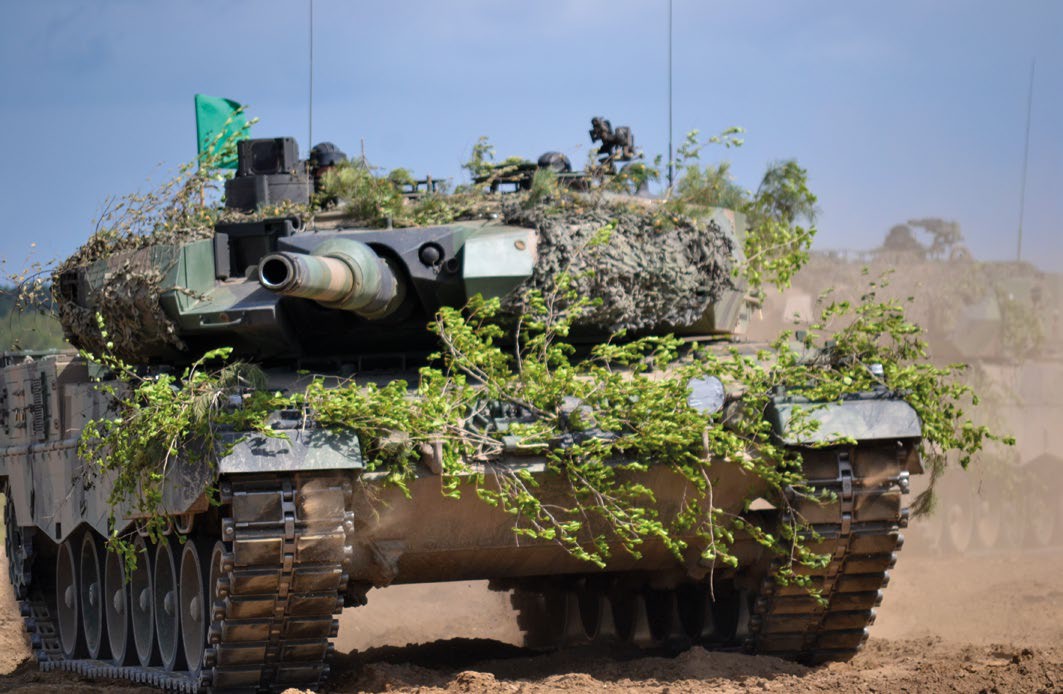
A well-camouflaged Leopard 2A5 of 11 Lubuska Dywizja Kawalerii Pancernej takes up position at the Drawsko Pomorskie Training Areas in Poland as part of the Defender Europe exercises in May 2022. (US Army photo by Capt. Tobias Cukale)
The Leopard 2 is the most widely used Main Battle Tank in NATO, equipping the armoured forces of Germany, Canada, Austria, the Netherlands, Poland, Spain, Denmark, Sweden, Norway, Finland, Greece, Portugal, Switzerland, Hungary and Turkey. In its four decades of service, it has undergone various productions changes and is widely acknowledged as the most effective MBT on the modern battlefield.
Development
The origins of the Leopard 2 can be traced back to the 1960s and the failed MBT-70 project between the Federal Republic of Germany and the United States. In 1967 the West German government ordered Porsche to begin developing a replacement for the Leopard 1, the so-called vergoldeter Leopard (‘Gilded Leopard’). At the end of this process in 1970 there existed two prototypes, the Keiler or ‘Tusker’. Beginning in 1970 Kraus-Maffei began the assembly of seventeen prototype turrets, ten armed with a 105mm smoothbore gun and the remainder with a 120mm smoothbore cannon, both developed by Rheinmetall. Sixteen of the planned seventeen chassis were built, fourteen with a conventional torsion bar suspension and the other two with the innovative hydropneumatic system developed for the MBT 70. These prototypes very much resembled the Leopard 1 with a sloping turret but had a completely new hull while using the tracks and roadwheels from the MBT-70. By 1973 the first prototypes were ready for testing by the Bundeswehr and two years later two vehicles were shipped to Canada and the United States for testing under climatic extremes.
These prototypes had already exceeded the specified 50-ton weight limit, so Wegmann developed a lighter turret known as the ‘Spitzmaus-Turm’ (Shrew Turret). This was also fitted with the state-of the-art EMES 13 co-relation rangefinder than could be incorporated in the turret front. This was included in subsequent prototype turrets. The experience of Israeli armour during the 1973 Yom Kippur War had reinforced the primacy of armour in the minds of Western tank designers and, in October 1974, it was accepted that the new German tank would have to have an increased maximum weight of 60 tons. One of the existing prototype turrets was thus modified with a new type of multi-layered armour.
On 11 December 1974 the FDR and the United States signed a Memorandum of Agreement to standardise certain components of their new Main Battle Tanks. This included joint trials of the putative Leopard 2 and the American prototype, Chrysler’s XM1. As a result, Kraus-Maffei assembled two new prototype chassis and three turrets. This version was known as the Leopard 2 AV (‘Austere Version’). This tank was the first to have the characteristic slab-sided turret of the production-series Leopard 2. Each of the turrets had different configurations of sights and gunner’s controls. Two were initially fitted with the 105mm gun for testing in the United States, while the third prototype turret was fitted with the 120mm gun from the outset. In August 1976 one complete prototype Leopard 2AV, one hull with extra weight to simulate the weight of the turret, and a separate hull and turret were flown to the United States for trials.
The trials were held at the Aberdeen Proving Ground in Maryland between September and December 1976. The XM1 had previously undergone the same test regime. The Leopard 2AV was found to be
the equal of the XM1 in terms of both firepower and mobility, but the German tank had superior protection. It was with some degree of chagrin that the German designers realised that many of the innovations in the two prototypes sent to America three years earlier had shaped the development of the XM1. For political reasons as much as military and technological, at the end of the trials the two nations decided to press ahead with the development of their own MBTs, the 105mm-armed M1 Abrams and the 120mm-armed Leopard 2.
Into Service
In 1977 the decision to procure the Leopard 2 as the Bundeswehr’s new Main Battle Tank was approved by the FDR’s Board of Defence and Budget Committee. 1,800 Leopard 2s were to be built and delivered to the Bundeswehr in five production batches. Two companies, Krauss-Maffei and Maschinenbau GmbH of Kiel (MaK) were selected as the main contractors for series production, with Krauss-Maffei producing 55% of the new tanks and MaK the remainder. Waggonfabrik und Fahrzeugbau Wegmann of Kassel was given responsibility for the turrets and the EMES 15 fire control system. It was decided to expedite the delivery of the new tank to the Bundeswehr even though some components, most notably the planned thermal tank sights, were not yet ready. In October 1978 Kraus-Maffei handed over the first completed chassis to the Bundeswehr for approval and in the following February two more production-series vehicles and a third turret were completed for testing at the German Armour School in Münster. These proved successful and on 25 October 1979 in a ceremony at the German Armour School the Bundeswehr received its first Leopard 2 into service. By 1982 380 Leopard 2s had been produced. Various production improvements followed and when the last Leopard 2A4 was produced for the German army in March 1992, 2,125 tanks had been produced.